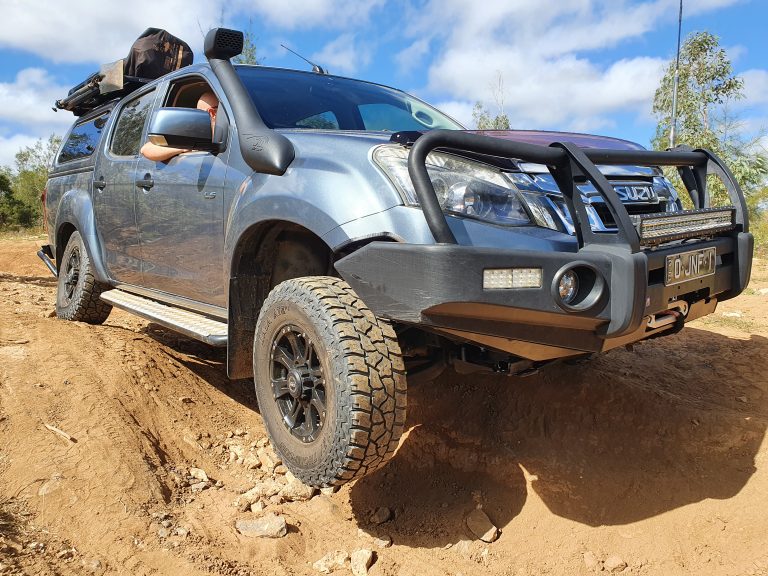Getting Traction – By Josh Behrendorff
Four-wheel driving success comes down to one thing, getting traction. Sounds simple right? Unfortunately getting traction in some very demanding terrain is not always that simple. As a driver we can point the car on the best line of the track, yet if for one reason or another you lose traction and forward momentum, it leaves you with the option to either line up for another attempt with more power (which usually breaks things) or drag the winch out.
When setting up an off-roader there is a couple of things that I recommend taking into consideration, the first being suspension. With a good aftermarket suspension lift kit of around 2” it won’t only increase your ground clearance, but will also improve the ride and handling of your vehicle off-road. It will increase the travel of your vehicle as it articulates over uneven terrain, keeping wheels on the ground ensuring that you get the most traction.

A well set up 4wd is comparable to a boat, it is more than just a mode a transport, it can be a way to escape the hustle and bustle for a bit of RnR.
Unfortunately, most new vehicles have independent front suspension (IFS) which are a weaker design compared to the older style solid axle design that made the older Nissan Patrols such an off-road weapon. The benefit of IFS is that it is a smoother and better ride, unfortunately they do not allow for the same flex as a solid axle vehicle and therefore they are more likely to break parts.
The front of my dmax which is also an IFS front end is the weakest part of my vehicle. I am always wary of not overloading the front CV shaft which can occur when bouncing wheels on and off the ground under acceleration on tough terrain. The steering rack, steering arms and sway bar linkages are also a weak point that without due care will easily ruin your trip off road. All of these things get put under extra stress with larger tyres and when an aftermarket suspension lift gets installed it changes the angles. All is not lost though as many aftermarket options are now available to rectify this design flaw and help you to keep moving. After 80 000km, my first set of aftermarket suspension is due to be replaced, I was running EFS suspension and have decided to move away from that manufacturer. The new Dobinson adjustable front struts allow me more flexibility to set it up in a way tailored to my vehicle and driving style. To compliment this, I installed a diff drop kit which reduced the CV angles closer to the manufacture’s specification. The aftermarket upper control arms that I fitted correct the caster angle of the front wheels to ensure longevity with correct tyre wear. I have also installed heavy duty aftermarket sway bar linkages to eliminate the risk of them bending or breaking. This set up has got me almost everywhere I wanted to go, until recently. Which brings me to the next point, traction control.

All modern vehicles have some type of traction control/stability control system installed by the manufacturer. The Isuzu has a two-part system, the first part limits engine power when it senses that the wheels are spinning. This is a major issue when driving on soft sand or mud when you may need some controlled wheel spin to keep momentum. The second stage of traction control in the Isuzu is to apply the brake to the wheel that is spinning to try and get the opposing wheel to turn. They set this system up to avoid having to install diff locks or a limited slip differential into the vehicle. For the most part their system (when correctly operated) has got me everywhere I have needed to go, which includes some very ugly terrain while traversing the old Telegraph trail in Cape York.
Yet the whole idea to apply brakes to a wheel that is spinning too much will soon slow momentum, particularly on a steep rubbly hill climb with offset cambers. By definition, Isuzu wants the vehicle to accelerate harder if a wheel lifts in the air so the traction control system can do its thing, yet this is exactly the torture that is so well known to break CV’s and steering arms. I have recently noticed the latest Isuzu dmax will come out with factory diff locks and this was my solution I have taken to prevent any front-end breakages. A Harrop E-Locker, installed into the rear diff, locks the rear differential up at the touch of a button which means both rear wheels will always spin at the exact same time. This stops the traction control system applying breaks when I need acceleration and also means that I don’t need to try and jump the vehicle over difficult terrain. Rod Stewart from Stewarts 4WD parts are not only able to supply but also fit the e-locker into the diffs ensuring you will have a true 4WD. With a diff lock now installed I can just allow the vehicle to crawl in low range even if I have wheels lifting off the ground in extreme terrain.
The old saying about proper preparation prevents piss poor performance is part of the idea behind all this, but a well set up car and smart driving technique will also prevent gear failure when you are stuck out on a remote track outside of phone reception. Just like fishing and boating, the initial set up costs can be painful, but it will pay dividends in the long trouble-free run off-roading. Until next time stay safe and tight lines.

Using your 4wd to escape the crowds has been able to put our family onto some great shore-based fishing locations.





